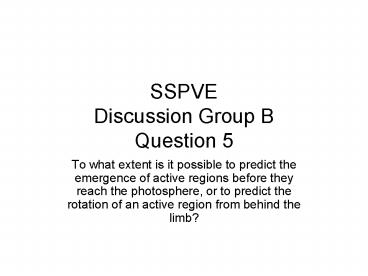SSPVE Discussion Group B Question 5 - PowerPoint PPT Presentation
1 / 18
Title:
SSPVE Discussion Group B Question 5
Description:
SSPVE Discussion Group B Question 5 – PowerPoint PPT presentation
Number of Views:81
Avg rating:3.0/5.0
Title: SSPVE Discussion Group B Question 5
1
SSPVEDiscussion Group BQuestion 5
- To what extent is it possible to predict the
emergence of active regions before they reach the
photosphere, or to predict the rotation of an
active region from behind the limb?
2
Local Helioseismology
- Three major techniques
- Ring Diagrams
- Large-scale flows show kinetic helicity pattern
below flare producers - Time-Distance
- Sound speed signature seen before AR emergence
- Acoustic Holography
- Provides farside images of ARs
3
Ring Diagrams - I
- Three-dimensional power spectrum of solar
oscillations - Subsurface flow displaces rings
No tracking for solar rotation
With tracking
4
Ring Diagrams II
- Perform analysis over solar disk
- Invert for horizontal flows as function of
location and depth
5
Ring Diagrams -III
- Assuming incompressible flow and using solar
model density - Derive vertical velocity and fluid dynamics
descriptors divergence, vorticity, helicity,
enstrophy
6
Vorticity below strong flare producers
AR 10069
AR 10486
7
Correlation between kinetic helicity and flare
activity
Recently completed study of 408 ARs Must have
both a strong dipolar vorticity signal deep down
and a strong B for high flare activity. Low
activity can occur over a wide B range, but is
associated with low vorticty.
8
Temporal behavior of kinetic helicity before a
flare
9
Time-distance
- Sound is emitted from a location, travels down,
and comes back up at some time later and some
distance away from the source. - The time and distance is influenced by the
conditions of the plasma that the wave travels
through.
10
Constructing a T-D plot
- At a given time T, compute the cross-correlation
between a point and annuli centered on the point
with different radii D. - Repeat for many values of T, plot
cross-correlation amplitude as a function of T
and D. - Can be done approximately by taking the power
spectrum of a filtered oscillation power
spectrum.
11
Observed time-distance diagram
Cross-correlation function is well described by a
Gabor wave packet
12
T-D diagnostics
- Changes in travel time are related to subsurface
conditions (sound speed, flows) - Can be inverted to infer the conditions
13
AR 10488 emergence
Sound speed from Time-Distance
14
(No Transcript)
15
Farside imaging
- Uses acoustic holography
- Time reverse observed wave field to an impulse at
a specific depth - Depth can be located at the farside surface
- Presence of active region causes phase shifts
16
Farside imagesof AR10808
17
The answer
- We can see very large regions on the farside,
giving up to 14 day warning before appearance on
disk (or all-clear signal). - We can see large regions form below the surface
on the disk, giving 1-5 day warning. - We are starting to see that specific flow
configurations are likely activity producers and
that there may be precursor temporal variations. - BUT
18
What do we need to do?
- More statistics, establish confidence levels.
- Better understanding of flare-related flow
characteristics - Tighter connection with surface observations
what is the relation between the flow and the
surface neutral line? - Incorporation of subsurface flows into CME/Flare
initiation models - Energy analysis V vs B, is there a CME or SEP?
- Faster analysis
- Calibration of farside signal vs activity B
- Compare flows and vector magnetograms































